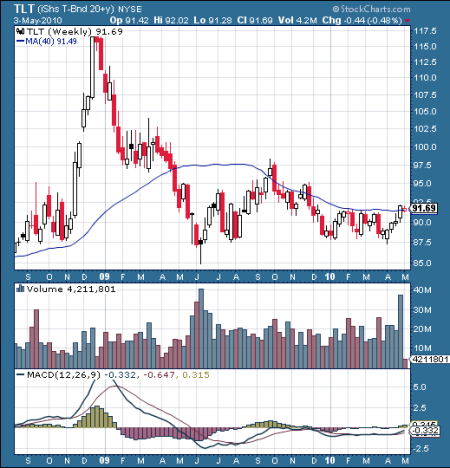SPX – 1202.26
DJIA – 11,151
“There exists in nature a strong propensity to depreciate the advantages and to magnify the evils of the present times.”
-Edward Gibbon
Generally subject to mood swings, Mr. Market’s behavior changed over the last three weeks, cycling rapidly between manic buying and depressive selling, the buying elevated by positive earnings and frenzied short covering, with selling triggered by distress over Europe’s PIIGS, delusional or not. Based on swing chart patterns and six distribution days for the S&P 500 (SPX), I think the trend is about to change but it hasn’t reversed yet. A distribution day is recorded when the market closes lower on higher volume and five or six distribution days over a few weeks or so warns an uptrend is at risk. The streak in this stretch includes two 90%-down days.
A SPX trade below last week’s low (1181.62) indicates a correction is likely underway. The 21-day low for the SPX is 1175.12 and if violated, likely provides the first confirmation, beating the MTI, my favorite trend following tool, to the punch. The Market Trend Indicator (MTI) remains in an UPTREND because each index is above its respective 18% weekly exponential moving average, 1170.57 for the SPX this week, and 10,847 for the DJIA. The New York Advance/Decline line is 7,955 advances above its 18% average.
NYSE net volume overbalanced a week ago with a (33.5) reading overbalancing its +22.1 hurdle rate. NASDAQ net volume is positive, its +44.5 peak reading is still in force, a peak recorded on March 10 while last week’s selling produced a peak reading of only (24.5) so it wouldn’t take much buying to reconfirm uptrend for both NASDAQ and the NYSE. Look out if neither can.
Small cap stocks fell more than blue chips last week and by sector, Financials, Basic Materials and Technology fell the most last week while Utilities, Telecom and Health Care fell the least, indicating the sectors that led the advance are likely to fall the most in a correction while money shifts at the margin to more defensive sectors. Mortgage REITs were among the worst performers for three months, probably reflecting the Fed’s exit from buying mortgages. A broader question is has the stock market begun to discount the end of quantitative easing, leaving the economy to stand on its own. Nonferrous Metals slipped into the bottom ten list, burdened by a month long slide in copper prices and perhaps suspicious of a slowing in China. The World Expo opened in Shanghai last week but note how the Shanghai Stock Exchange Composite Index is trending lower after failing to surpass its 2009 highs.

Shanghai Financial District Skyline (Source: Boson Globe, http://www.boston.com/bigpicture
The Wall Street Journal had a good article over the weekend on the strength in small cap stocks. Small cap stocks typically outperform when interest rates are low with leadership faltering when interest rates are rising. Small cap has outperformed large cap since the top in 2000, just over ten years and reportedly the longest streak on record, besting the 1974-1983 run. These cycles usually last about seven years and I thought it was ending at the 2007 bull market high. The Russell 2000 fell 60% and the S&P SmallCap 600 59% during the bear market compared to 58% for the SPX and 54% for the DJIA. But even after the first surge off the low, small cap stocks led the bull market charge with the S&P SmallCap 600 index up nearly 119% and Russell 2000 up 118% through last week’s high compared to nearly 90% for the SPX and 74% for the DJIA. As a rule of thumb, I generally start looking for a change with the P/E ratio on SML is two times the SPX. From the Journal’s article, here’s a table showing various ratios today.
Ratio S&P SmallCap 600 S&P 500
Forward P/E 22x 15x
Earnings growth estimate 130% 42%
P/E to growth rate (PEG) 0.17 0.38
Price/Sales 0.98 1.21
Price/Book Value 2.6x 1.2x
Dividend Yield 0.95% 1.21%
In other markets, long-term government bond prices rallied enough to stop me out of a short position. I suspect the rally could carry further if stock prices correct but I’m not interested in a long trade, preferring to stand aside and reinitiate a short position via inverse exchange traded funds (ETFs) such the ProShares Short Barclay’s 20-year+ Treasury (TBF) and ProShares UltraShort Lehman 20-yr. Treasury (TBT).
Further down the quality spectrum, Dealogic reported that new junk bond sales totaled $36.7 billion in March and April, the largest issuance on record for a two month period. A headline in yesterday’s Financial Times pointed out Rally has junk debt trading at close to face value while The Wall Street Journal last Saturday read ‘Junk’ Draws a Crowd, High-Yield Bond Market Booming Despite a Bulging Supply. What neither publication pointed out is that yield spreads moved towards higher quality bonds over the past four weeks, a trend that picked up speed last week. I suspect a more contrarian defensive stance is in order.
As for currencies, the U.S. Dollar index trended higher, producing a 7th swing in its 3-day swing chart as Euro competition waned amid sovereign debt issues. Federal Reserve policy in the U.S. was unchanged but comments on the economy were more positive, reflection improvements in labor markets versus stabilization a month earlier. I still liken the competition between currencies as the “best horse in the glue factory” sort. Warren Buffet explained at the Berkshire Hathaway annual meeting, “Based on what I see happening around the world, currencies are a poorer bet than they have been for some time. If inflation ever really gets in the saddle, it gets very unpredictable. Faith in institutions can break down.”
Gold, which typically moves contrary to the greenback, is trading higher despite strength in the dollar. It’s outperforming virtually all currencies, a trend I expect to continue in and possibly picking up speed in coming months. Gold is well past the “buy low” category; in fact I think the speculative phase of the bull market is already underway, much like Internet in 1999 with a final rush at some point culminating in front page headlines and magazine covers in the general press. That’s when it’s time to sell. In the interim, I’m maintaining recommended stop sell positions just under the February 5 low ($1058 2nd London fix) for traders and under last September’s low ($989.50) for long time investors.
Harmonic Preview:
(High Probability SPX Turning Point or Acceleration Days)
May 7 (Friday)
May 13 (Thursday)
*An asterisk denotes a dynamic SPX price square in time; different factors account for the other dates.
New ETFs are started weekly but it’s a challenge for most to attain critical mass. ProShares started trading four new international ETFs with double leverage- Ultra MSCI Europe (UPV), Ultra MSCI Pacific Ex-Japan (UXJ), Ultra MSCI Brazil (UBR) and Ultra MSCI Mexico (UBM). Rydex closed 12 of is 14 leveraged ETFs, ceding the market to ProShares.
Conclusion:
My recommend stops for ETFs ties to the SPX and Nasdaq (100) were hit last week. Rightly or wrongly, they were set particularly tight. If the SPX were to regain its trendline connecting its February 5 and April 9 lows, I’ll be muttering to myself, “way to go Gibson, cutting profits,” but it would be minor trading positions only on the long side if that were to happen.
I favor short candidates tied to the strongest areas not the weakest as I expect institutions to shift at the margin to defensive groups. Size positions for a counter trend move. Appropriate inverse ETFs include SBB (ProShares Short S&P SmallCap 600) and RWM (ProShares Short Russell 2000) and for double leverage, SDD (ProShares UltraShort SmallCap 600), TWM (ProShares UltraShort Russell 2000) and SMN (ProShares UltraShort Basic Materials).
For investors, the SPX is a long way from any sort of signal that would say to run for cover but it’s a good time to clean up portfolios in accordance with your strategy. From Ned Davis Research, its data shows that since 1952, the average six month gain for the SPX is 1.58% for the May through October period versus a 6.36% gain for the November through April period.
The information contained herein is based on sources that William Gibson deems to be reliable but is neither all-inclusive nor guaranteed for accuracy by Mr. Gibson and may be incomplete or condensed. The information and its opinions are subject to change without notice and are for general information only. Past performance is not a guide or guarantee of future performance. The information contained in this report may not be published, broadcast, rewritten or otherwise distributed without consent from William Gibson.




